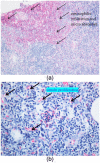A case series of Kimura's disease: a diagnostic challenge
- PMID: 30013767
- PMCID: PMC6041861
- DOI: 10.1177/2040620718780370
A case series of Kimura's disease: a diagnostic challenge
Abstract
Kimura's disease (KD) is a rare, benign disorder characterized by subcutaneous masses with regional lymph-node enlargement. It is considered to be due to chronic inflammation of unclear etiology. Most cases have been reported in young, 20-30-year-old men of Asian descent. The diagnosis of KD is based on pathological features and elevated immunoglobulin E levels. Characteristic pathological features include intact lymph-node architecture, florid germinal center hyperplasia, extensive eosinophilic infiltrates, and proliferation of postcapillary venules. However, these features can also be seen in Hodgkin's disease or T-cell lymphoma, therefore, cases presenting as KD pose a diagnostic challenge. We report a case series of two cases with suspected KD at initial presentation, with one patient eventually diagnosed with Hodgkin's disease after clinical progression. The first case was a 45-year-old Asian man who presented with bilateral thigh masses and significantly enlarged inguinal lymph nodes. The histopathology was characteristic and the patient had stable disease on treatment with cetirizine for 20 months. The second case was a 29-year-old African-American man who had progressive enlargement of the right neck lymph nodes extending into the mediastinum, with the original biopsy suggestive of KD. An initial search for Reed-Sternberg cells using immunohistochemical staining for CD15 and CD30 was negative. However, the patient developed neurological symptoms corresponding to tumor extension to the cervical and thoracic neural foramina. A repeat biopsy showed a lack of nodal structure and atypical large cells that were positive for CD30 staining. The patient was treated with chemotherapy with good response. We emphasize the importance of following the clinical course to render an accurate diagnosis. Both cases showed extensive eosinophilic infiltration and other KD-like pathological features. However, KD is rare; not missing a malignant diagnosis lies in high clinical suspicion and repeated exhaustive work up.
Keywords: Hodgkin’s lymphoma; Kimura’s disease; eosinophilia; immunoglobulin E.
Conflict of interest statement
Conflict of interest statement: The authors declare no conflicts of interest in preparing this article.
Figures


References
-
- Chen H, Thompson LD, Aguilera NS, et al. Kimura disease: a clinicopathologic study of 21 cases. Am J Surg Pathol 2004; 28: 505–513. - PubMed
-
- Kuo T, Shih L, Chan H. Kimura disease. Involvement of regional lymph nodes and distinction from angiolymphoid hyperplasia with eosinophilia. Am J Surg Pathol 1988; 12: 843–854. - PubMed
-
- Kung ITM, Gibson JB, Bannatyne PM. Kimura’s disease: a clinicopathological study of 21 cases and its distinction from angiolymphoid hyperplasia with eosinophilia. Pathology 1984; 16: 39–44. - PubMed
-
- Hui PK, Chan JK, Ng CS, et al. Lymphadenopathy of Kimura’s disease. Am J Surg Pathol 1989; 13: 177–186. - PubMed
-
- Kimura Y, Pawankar R, Aoki M, et al. 205 Cytokines expressed by mast infiltrating the lesions of Kimura’s disease. J Allergy Clin Immunol 2000; 105: S66.
Publication types
LinkOut - more resources
Full Text Sources
Other Literature Sources

